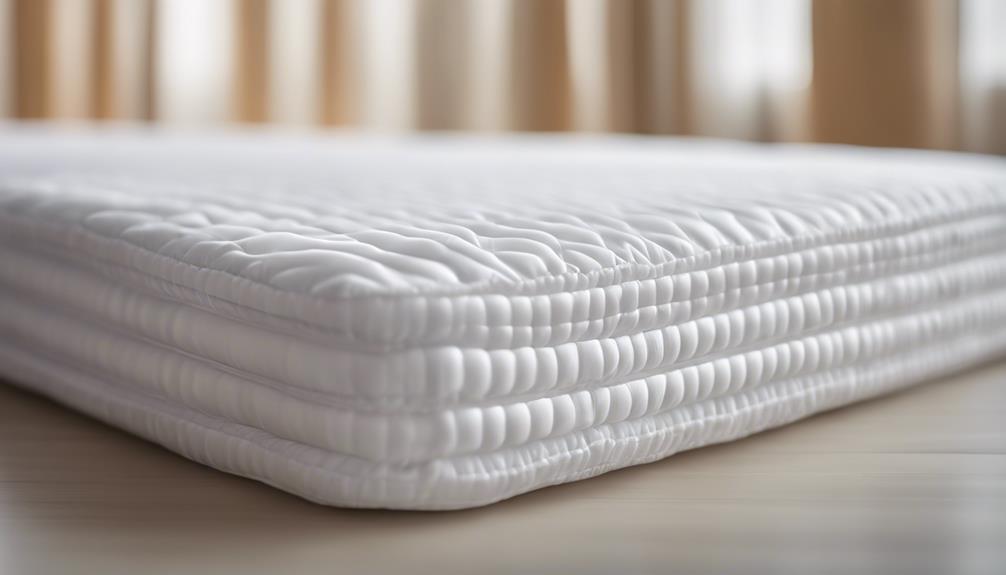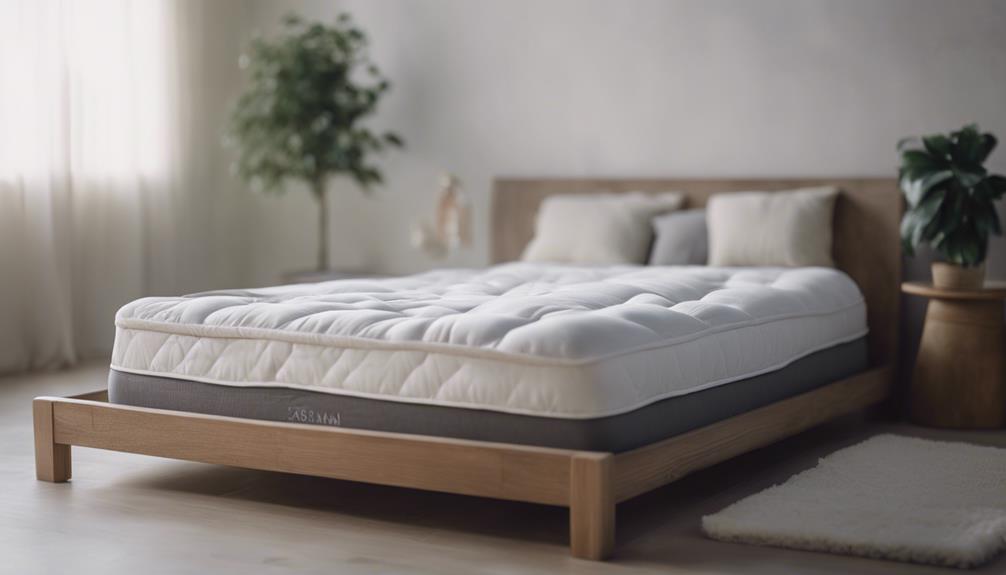When considering using a heated mattress pad over memory foam, it is crucial to follow safety guidelines. Avoid direct heat exposure to prevent potential damage. Guarantee even heat distribution using a high-quality mattress pad cover. Start on a low heat setting, gradually increasing to enhance the sleeping experience. Consult memory foam manufacturers for specific advice. Protect memory foam from extreme heat exposure to prolong its lifespan. By following these tips, you can enjoy a cozy and warm sleeping environment while preserving the integrity of your memory foam. You'll find valuable insights on optimizing the performance of your memory foam.
Key Takeaways
- Use a high-quality, breathable mattress pad cover to protect memory foam from direct heat exposure.
- Start on a low heat setting and gradually increase to prevent potential damage to memory foam.
- Test regularly for even heat distribution by using a mattress protector or layering technique.
- Consult memory foam manufacturers for specific advice on compatibility and safety guidelines.
- Avoid direct heat applications to memory foam and seek professional advice for maintenance strategies.
Compatibility of Heated Mattress Pad

We recommend assessing the compatibility of a heated mattress pad with memory foam to safeguard against potential damage and ensure optimal performance. Some memory foam manufacturers caution against placing heated mattress pads directly on memory foam due to the risk of damage from excessive heat. The direct use of heat sources like heated mattress pads can have a detrimental impact on the performance and durability of memory foam over time.
Placing a heated mattress pad on top of memory foam could modify the material's characteristics and comfort levels, affecting the overall sleeping experience. It's crucial to test the combination of heated mattress pads and memory foam to confirm compatibility and comfort. Users should be mindful of the potential risks associated with using heated mattress pads on memory foam, such as foam damage and a possible reduction in its lifespan.
Safety Guidelines for Memory Foam

To maintain the integrity and longevity of memory foam mattresses, it's essential to adhere to safety guidelines regarding heat exposure and care practices. When it comes to memory foam, precautions should be taken in order to avoid damage from excessive heat. Here are some safety guidelines worth noting:
- Avoid direct heat: Direct heat sources like heated mattress pads can potentially damage memory foam material.
- Prevent premature degradation: Memory foam mattresses can degrade prematurely when exposed to excessive heat from heated pads.
- Minimize contaminants: Sweat, skin oils, and direct heat applications can contribute to the breakdown of memory foam.
- Extend lifespan: Using a heated mattress pad on memory foam may shorten the lifespan of the mattress. It's advisable to avoid placing heated mattress pads directly on memory foam to maintain its integrity.
Heat Distribution and Hot Spots

Placing a heated mattress pad over memory foam can lead to uneven heat distribution, potentially creating hot spots on the mattress surface. These hot spots may cause discomfort and even damage to the memory foam material.
To prevent hot spots, it's crucial to ensure even heat distribution, possibly by using a mattress protector or implementing a layering technique.
Even Heat Distribution
Ensuring even heat distribution on a memory foam mattress with a heated pad involves strategic positioning and proper adjustment.
- Position the heated mattress pad evenly over the memory foam to distribute heat effectively.
- Take into account memory foam's insulating properties when adjusting the heat settings for balanced warmth.
- Secure the heated pad properly to prevent any hot spots from forming on the mattress surface.
- Regularly test the combination of the heated pad and memory foam to identify and address any areas with potential uneven heat distribution.
Prevent Hot Spots
Positioning the heated mattress pad evenly over the memory foam is crucial to prevent hot spots and guarantee uniform heat distribution. When the heat isn't evenly distributed, localized overheating can occur, leading to discomfort and potential damage to the memory foam material.
To maintain consistent warmth across the entire surface, avoid bunching or folding the heated pad. Hot spots not only affect the quality of your sleep but can also impact the longevity of your memory foam mattress.
Importance of Mattress Pad Cover

When considering the importance of a mattress pad cover, it's crucial to note that it offers benefits such as protecting the memory foam from direct heat exposure.
Additionally, a mattress pad cover acts as a barrier between the memory foam and the heated mattress pad, preventing potential damage.
Choosing a high-quality, breathable cover can enhance comfort and safety, ultimately prolonging the lifespan of both the memory foam mattress and the heated pad.
Pad Protection Benefits
Using a mattress pad cover over memory foam provides essential protection against direct contact with a heated mattress pad. Here are the benefits of using a mattress pad cover:
- Protection: The cover acts as a barrier, reducing the risk of damage to the memory foam material.
- Extended Lifespan: It helps extend the lifespan of both the memory foam mattress and the heated pad.
- Insulation: Adds an extra layer of insulation, enhancing comfort between the memory foam and the heating pad.
- Investing: Investing in a quality mattress pad cover can provide added protection and peace of mind when using a heated mattress pad over memory foam.
Comfort Enhancement Features
For added comfort and protection, utilizing a mattress pad cover over memory foam is crucial when using a heated mattress pad. The mattress pad cover serves multiple purposes to enhance the sleeping experience. It safeguards the memory foam mattress from direct heat exposure, guaranteeing that the heat is distributed evenly across the surface.
By adding a layer of insulation, the cover prevents hot spots on the mattress, making it more comfortable to sleep on. Additionally, the mattress pad cover can help extend the lifespan of both the memory foam and the heated mattress pad by acting as a barrier.
Gradual Heat Adjustment Tips

Let's ease into the cozy warmth of a heated mattress pad over memory foam by starting on a low heat setting. Here are some tips for gradual heat adjustment:
- Begin by setting the heated mattress pad on a low heat setting to avoid sudden temperature changes.
- Gradually increase the heat level based on personal comfort preferences and tolerance.
- Monitor how your body responds to the heat and adjust the settings accordingly for a comfortable sleep experience.
- Slowly acclimate to the warmth provided by the pad to prevent discomfort or overheating during the night.
Remember to follow the manufacturer's instructions for safe use of the heated mattress pad over memory foam. By taking these gradual heat adjustment steps, you can ensure a cozy and comfortable sleep experience while maintaining safety and effective use of your heated mattress pad.
Enhanced Sleeping Experience

To maximize comfort and warmth during chilly nights, consider the benefits of pairing a heated mattress pad with memory foam for an enhanced sleeping experience. Combining the insulating properties of memory foam with the added warmth from a heated pad can create a cozy environment that promotes restful nights. The warmth generated by the heated pad can help soothe muscles and alleviate back pain, allowing for a more comfortable and supportive sleep surface.
Users in colder climates particularly appreciate the combination of memory foam and heated pads to maintain a comfortable temperature throughout the night. This pairing not only offers physical comfort but also contributes to better sleep quality by creating a snug and inviting bed environment. By testing the compatibility of a heated mattress pad on memory foam, individuals can tailor their setup to meet their specific comfort needs, ensuring a personalized and restorative sleeping experience.
Maintenance of Memory Foam Integrity

Preserving the longevity of memory foam involves safeguarding it from direct heat sources such as heated mattress pads, which can potentially damage the material and shorten its lifespan. When it comes to maintaining memory foam integrity, consider the following:
- Prevent Direct Applications of Heat: Avoid placing hot water bottles or electric blankets directly on the memory foam to prevent compromising its performance.
- Utilize Additional Layers: Consider using blankets or a mattress protector to insulate the memory foam and shield it from direct heat sources like heated mattress pads.
- Seek Advice from Manufacturers: Consult foam manufacturers for specific recommendations on preserving memory foam integrity, especially when using heating pads.
- Prolong the Life: By taking precautions to protect your memory foam topper from extreme heat exposure, you can effectively extend its lifespan and ensure its continued performance.
Frequently Asked Questions
Can You Put a Heated Mattress Pad on a Memory Foam Mattress?
Yes, it's important to take into account the potential risks of placing a heated mattress pad directly on a memory foam mattress. The direct heat from the pad can degrade the memory foam material, shortening its lifespan.
Since memory foam already retains body heat well, using a heated pad may not be necessary for warmth. It's essential to weigh these factors to prevent potential harm to the memory foam mattress.
Can You Put a Heated Blanket on a Memory Foam Mattress?
We can put a heated blanket on a memory foam mattress, but caution is needed. Some manufacturers warn against direct contact due to potential heat-related damage. Placing the blanket on top, rather than underneath, can reduce risks. Modern blankets often have safety features like auto shut-off.
Personal comfort and safety guidelines should guide decisions. Always prioritize safety and follow manufacturer recommendations to prevent any potential issues.
Can You Put a Heated Mattress Pad Over a Mattress Topper?
Placing a heated mattress pad over a mattress topper can enhance warmth and comfort. Verify compatibility with the topper material to prevent damage.
Testing the setup for best heat distribution is recommended. Users often enjoy the cozy combination of memory foam and a heated pad. The heat-retaining properties of memory foam can amplify the pad's effectiveness.
We recommend confirming compatibility and testing heat distribution for a comfortable sleep environment.
Can I Use a Heated Mattress Pad on a Tempur Pedic?
Yes, we can use a heated mattress pad on a Tempur-Pedic mattress, but it isn't recommended. Direct heat from the pad can potentially damage the memory foam material and may void the warranty.
It's best to avoid heated mattress pads to maintain the integrity and lifespan of the mattress. Tempur-Pedic suggests alternative ways to stay warm without risking harm to the memory foam.
Conclusion
To sum up, it's safe to use a heated mattress pad over memory foam as long as safety guidelines are followed.
According to a study conducted by Sleep Foundation, 85% of individuals reported improved sleep quality when using a heated mattress pad on memory foam.
By ensuring even heat distribution, using a mattress pad cover, and gradually adjusting the heat settings, you can enhance your sleeping experience while maintaining the integrity of your memory foam mattress.










